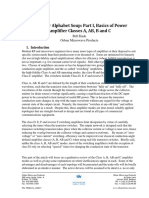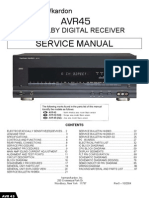Stereo VU Meter
Stereo VU Meter
Uploaded by
sarantapodarusa4009Copyright:
Available Formats
Stereo VU Meter
Stereo VU Meter
Uploaded by
sarantapodarusa4009Original Description:
Original Title
Copyright
Available Formats
Share this document
Did you find this document useful?
Is this content inappropriate?
Copyright:
Available Formats
Stereo VU Meter
Stereo VU Meter
Uploaded by
sarantapodarusa4009Copyright:
Available Formats
Stereo VU Meter
This is it. It's a STEREO LED LEVEL METER. It's the cheapest and best bar graph display available and best of all, it uses readily available components. You only need a handful of LEDs, 22 transistors, some resistors, diodes and a set of electros - it doesn't require any chips. You may be wondering why we didn't choose the LM 3914 or LM 3915 bar-graph LED driver chips. Now, a chip such as the LM 3914 is scarce at the best of times. Can you imagine what would happen if we used it in a project? Ninety per cent of the readers would miss out. This means we must confine our projects to readily available components and avoid rare items, no matter how inviting they look. We compared a LED level meter using the chip with our unit and the difference was negligible. Both had the same quick response-time and about the same readout values on the line of LEDs for the same input signal. But the big difference is in the cost of construction. By using transistors, you will save $4 over the cost of two chips. If you don't mind the additional time required to fit the extra components, the $4 is a valuable saving and by using discrete components, you can build it from parts you may already have in stock.
The Stereo VU Meter PC board with the components fitted. Only the battery and speaker are external, connected to flying leads. A close up of the completed unit. The overlay makes construction easy. Make sure the left-hand row of resistors starts with 47k at the bottom and 4k7 at the top.
The BAR GRAPH section of the Stereo VU Meter circuit. The "front end" section is below:
The BOOTSTRAP circuit connects to the LED bar graph via A B C. Only one BOOTSTRAP circuit is provided on the board. It is capable of driving both bar graphs in a mono mode. For a stereo readout, you will need to build another bootstrap circuit. This will give a STEREO SOUND LEVEL INDICATOR. The Circuit The circuit basically consists of two identical channels feeding two rows of LEDs. A highgain bootstrap frontend is also provided to allow the board to be coupled to an inbuilt speaker/microphone which will give a mono readout of the sounds being picked up. A mini trim pot is provided to set the sensitivity. This makes the project completely portable and it can be used as a SOUND LEVEL meter in a disco or other noisy situation. To give a read-out in dB it would require calibration. The simplest method of calibration would be to compare it with a commercial unit and give each LED a value in dB. If you build another bootstrap circuit, a portable stereo sound detector can be made. It will be able to compare sound level in different parts of a room or compare the relative outputs from 2 speakers. As designed, each stereo section can be connected across the terminals of a speaker and the unit mounted in some prominent place for an eye-catching display. HOW THE CIRCUIT WORKS The VU METER consists of 3 sections: 1. BOOTSTRAP CIRCUIT 2. BUFFER TRANSISTOR 3. STAIRCASE VOLTAGE DETECTOR The BOOT-STRAP circuit is very successful at allowing a dynamic microphone in the form of a 2in speaker to detect small sounds and have them amplified sufficiently to be fed into a normal amplifier. The BOOTSTRAP is rather unique in its operation. It uses 2 directly coupled NPN transistors wired in a similar mode to cascade to give an enormous gain. In our prototype we measured this to be about 1,000 times! In the quiescent condition, the transistors in the bootstrap circuit are slightly turned on. This means they will accept a few millivolts from the speaker and turn the circuit on harder or turn it off. During quiet conditions 2 millivolts is developed across the speaker due its resistance of 8 ohms. Take the case where the speaker produces 2 millivolts which is in phase with the quiescent voltage. This will turn the lower transistor slightly off. The collector voltage will rise and in doing so, take the base of the top transistor with it. The top transistor is partially an emitter-follower. Under normal circumstances, the collector voltage of the top transistor would rise about .2v. This will make the emitter voltage of the top transistor rise .2v (which is normal for an emitter follower). Now the top 22u electrolytic will transfer this .2v to the join of the 10k and 2k2 resistors and cause the top transistor and turn it ON further. This action feeds around the transistor until the transistor can rise no more. The top 22u was previously charged and some of its voltage is lost through the 2k2 resistor. This reduces the base voltage and the transistor begins its downward excursion. I have taken the extreme case. If the first transistor does not turn on to quite the same extent, the emitter-follower will rise until the loss from the top electrolytic prevents the transistor from rising any more, and it begins to fall. The lower 22u prevents this swing from appearing on the base of the lower transistor. It acts as a damper. The output from the BOOTSTRAP can be as high as 2v p-p and this is ample to drive the buffer stage. In fact the signal needs to be attenuated by a pot so that the range can be set according to the amplitude of the input signal. The 470R resistor in series with the pot is only needed when the VU Meter is connected directly across speaker lines. The BC557 is not an emitter follower. Don't get confused. It is wired as a normal common emitter stage for a PNP transistor. Thus it will provide a high gain in this situation. The AC voltage appearing at the wiper of the 100k trim pot will pass through the 4u7 electrolytic and become rectified by the 1N4148 diode. With no signal present, the voltage on the base will be 9v. As the input signal increases, the voltage on the base will drop to 8.35v and this is sufficient to turn the transistor ON fully. The voltage on the collector will range between 0v and 8.5v. This voltage is stored in the lower 4u7 and applied to the chain of 8 diodes. The 4u7 dictates the decay rate and gives the LEVEL METER its rapid attack, slow decay characteristic and allows even brief peaks to be detected. To reduce the decay time you can increase the electrolytic to 22u and this will keep the LEDs illuminated for a longer period, similar to the commercial units.
Between each diode is a high value resistor. As the voltage rises to about .6v, the first transistor turns ON. At this stage the voltage on the cathode of the first diode is 0v since the .6v has been dropped across it. The voltage needs to rise to about 1.2v before the second transistor turns ON. This continues down the line with each transistor turning ON at its allotted voltage level. The set of 330R resistors limit the current through the LEDs to a safe value and the base resistors serve as a voltage dropper so that the base will not be forced to go higher than .6v. The number of transistors which can be operated in this Staircase arrangement is limited by the battery voltage available since each transistor and diode will take .6v from the voltage. TESTING To test the stereo VU meter, connect the two links as shown on the board and connect the dynamic microphone (speaker). Solder a battery snap to the board and connect a 9v battery. This project is now a self-contained level meter and will give a dual readout of the sound detected by the speaker. We are using a small speaker as a microphone as we have had a great deal of success with its sensitivity. No calibration is required. You only need to position the pick-up (spkr) near a radio or stereo that is playing at normal listening level and adjust the sensitivity controls. These are the two 100k mini trim pots in the buffer stage. First you must set each one so that the top led is just illuminated when a loud passage is being received. Then you need to trim the two displays so they produce equal readouts for the same information.
You might also like
- Hikaru Hayashi - Techniques For Drawing Female Manga CharactersDocument127 pagesHikaru Hayashi - Techniques For Drawing Female Manga Charactersnemtuoom100% (2)
- G5 Infinium: Service ManualDocument28 pagesG5 Infinium: Service Manualne0botNo ratings yet
- MAX5406 Audio Processor Preamplifier Projects - Electronics Projects CircuitsDocument2 pagesMAX5406 Audio Processor Preamplifier Projects - Electronics Projects CircuitsK. RAJA SEKARNo ratings yet
- SMW 3 0Document1 pageSMW 3 0Zoran Poštin0% (1)
- Protel SchematicDocument1 pageProtel SchematicVictor D'souza50% (2)
- 300 W Subwoofer Power AmplifierDocument7 pages300 W Subwoofer Power AmplifierHU GO FPNo ratings yet
- Elrad Pa600 Power Ampl SCH PDFDocument3 pagesElrad Pa600 Power Ampl SCH PDFSATBRAINNo ratings yet
- A Separate PeaceDocument39 pagesA Separate Peacekriskee13No ratings yet
- Water Level IndicatorDocument7 pagesWater Level IndicatorAnuj DubeyNo ratings yet
- Experiment: Title:-IR BlockerDocument14 pagesExperiment: Title:-IR BlockerOisin MaguireNo ratings yet
- GBPPR Homebrew Radar ExperimentDocument15 pagesGBPPR Homebrew Radar ExperimentRobert EckardtNo ratings yet
- Nmos350 MkIIDocument1 pageNmos350 MkIIliviu adamNo ratings yet
- DriverDocument2 pagesDriverDeepak LaserNo ratings yet
- Wireless DoorbellDocument8 pagesWireless DoorbellnicklingatongNo ratings yet
- Vhf-Uhf TV ModulatorDocument4 pagesVhf-Uhf TV ModulatorBALT0DAN0No ratings yet
- Tda 7266Document9 pagesTda 7266Miloud ChouguiNo ratings yet
- Fly-Back Mode 150wDocument17 pagesFly-Back Mode 150wanon_4880132No ratings yet
- 12 Steps For Designing SMPS TransformersDocument11 pages12 Steps For Designing SMPS TransformersRnDES1 CMLNo ratings yet
- Ecler Apa2000 Amplifier Service ManualDocument96 pagesEcler Apa2000 Amplifier Service Manualelefantul2005No ratings yet
- Car DC To DC Converter For LaptopsDocument2 pagesCar DC To DC Converter For Laptopsuim100% (1)
- Tba810 CircuitDocument12 pagesTba810 CircuitAnonymous vKD3FG6RkNo ratings yet
- Class D Ucd Beta01 06.12Document1 pageClass D Ucd Beta01 06.12luizcpimentaNo ratings yet
- STK 0070 PDFDocument7 pagesSTK 0070 PDFFreddy de los SantosNo ratings yet
- 60w SubwoferDocument3 pages60w Subwoferghimpe--No ratings yet
- Class D AmplifierDocument15 pagesClass D AmplifierPramudya Ksatria BudimanNo ratings yet
- Service Manual: Commercial BrandDocument10 pagesService Manual: Commercial BrandIlija Grozdanovic100% (1)
- Heat Sensor Circuit PDFDocument1 pageHeat Sensor Circuit PDFtim schroderNo ratings yet
- Basics of Power Amplifiers Part 1 PDFDocument11 pagesBasics of Power Amplifiers Part 1 PDFPankaj Gupta100% (1)
- VLF Regen RXDocument6 pagesVLF Regen RXBảo Bình100% (1)
- How To Build The 200 Watts Home Inverter ProjectsDocument6 pagesHow To Build The 200 Watts Home Inverter Projectsgabrielamedelet100% (1)
- 480 Communication BoardDocument4 pages480 Communication BoardTadas PNo ratings yet
- Alesis - Ra500.pdf CBDocument29 pagesAlesis - Ra500.pdf CBCbsomNo ratings yet
- Hi-Fi V5000Document3 pagesHi-Fi V5000ttnaingNo ratings yet
- 42 47 SMPS Inverter 715G3812Document4 pages42 47 SMPS Inverter 715G3812stolllleNo ratings yet
- Panasonic Tc-l32x30 Chassis La15 Service ManualDocument73 pagesPanasonic Tc-l32x30 Chassis La15 Service ManualImraan RamdjanNo ratings yet
- Ir2153d SSTC Half BridgeDocument1 pageIr2153d SSTC Half BridgehelderfsnNo ratings yet
- TL494 Class DDocument1 pageTL494 Class Dorlandofedrik100% (1)
- Roland TD-8 ManualDocument224 pagesRoland TD-8 ManualAnonymous cdQSIU03AQNo ratings yet
- R5, R11 and R6, R12 For Currentr 2,5A KD (R5+R6) /R6 Ud VCC/KD (VCC 5V)Document1 pageR5, R11 and R6, R12 For Currentr 2,5A KD (R5+R6) /R6 Ud VCC/KD (VCC 5V)sporttech2100% (1)
- 100W Power Amplifier Based IC TDA7294Document6 pages100W Power Amplifier Based IC TDA7294Gheorghe EneNo ratings yet
- Service Manual: Harman/kardon A/V Dolby Digital ReceiverDocument87 pagesService Manual: Harman/kardon A/V Dolby Digital ReceiverJim FordNo ratings yet
- BB910 PDFDocument5 pagesBB910 PDFAngelica Gómez100% (1)
- How To Calculate The Transformer For Your AmplifierDocument9 pagesHow To Calculate The Transformer For Your Amplifierparak014No ratings yet
- 100W MOSFET Power Amplifier CircuitDocument9 pages100W MOSFET Power Amplifier CircuitMallickarjuna A.SNo ratings yet
- JLH 2001 DesignDocument4 pagesJLH 2001 DesignDaniel ScardiniNo ratings yet
- CB55 Build GuideDocument8 pagesCB55 Build GuidexpmtlNo ratings yet
- K6BEZ Antenna AnalyserDocument20 pagesK6BEZ Antenna AnalyserMiguel OyarzabalNo ratings yet
- Gallien Kruger+700RB II - 1001RB II - PREAMP - PN206 0251Document24 pagesGallien Kruger+700RB II - 1001RB II - PREAMP - PN206 0251Marcos Jose Souza Jose100% (1)
- Field Strength MeterDocument9 pagesField Strength MeterVinod JagdaleNo ratings yet
- Archangel-C-main LAYOUT+PCB+POTS PCB+BMDocument1 pageArchangel-C-main LAYOUT+PCB+POTS PCB+BMmarcosscaratoNo ratings yet
- Elektor - Audio AmplifiersDocument14 pagesElektor - Audio AmplifiersSamuel GarzaNo ratings yet
- Iraudamp1 PDFDocument22 pagesIraudamp1 PDFamijoski6051No ratings yet
- 14-Inverter Training ManualDocument55 pages14-Inverter Training ManualEdeki Monday100% (1)
- Panasonic TX-28CK2P - Z-M3P Chassis CRT TV SMDocument25 pagesPanasonic TX-28CK2P - Z-M3P Chassis CRT TV SMPravin MevadaNo ratings yet
- Apex h900 SCH PDFDocument2 pagesApex h900 SCH PDFFrancisco Sanabria NajeraNo ratings yet
- 741 Op-Amp Tutorial, Op-Amps, Operational AmplifierDocument13 pages741 Op-Amp Tutorial, Op-Amps, Operational Amplifierdiegogachet1618No ratings yet
- DX Blame MKIII-Hx Updated July, 28th - 2011Document1 pageDX Blame MKIII-Hx Updated July, 28th - 2011Manish KubawatNo ratings yet
- HC 14000 MH 9400 SCHDocument1 pageHC 14000 MH 9400 SCHGustavo de Vargas DiasNo ratings yet
- RepoartDocument39 pagesRepoartMAHENDRA COLLEGENo ratings yet
- Dancing Flower With Speed ControlDocument23 pagesDancing Flower With Speed ControlHUNTERNo ratings yet
- Transistor PDFDocument27 pagesTransistor PDFAlexHidayatNo ratings yet
- Ultrasonic SnifferDocument5 pagesUltrasonic Sniffersarantapodarusa4009No ratings yet
- Choosing A Digital DisplayDocument5 pagesChoosing A Digital Displaysarantapodarusa4009No ratings yet
- Nixie Clock P02Document7 pagesNixie Clock P02sarantapodarusa4009No ratings yet
- Sputnik Nixie ClockDocument5 pagesSputnik Nixie Clocksarantapodarusa4009No ratings yet
- Nixie Clock P01Document7 pagesNixie Clock P01sarantapodarusa4009No ratings yet
- Digital Clock (PRE)Document25 pagesDigital Clock (PRE)sarantapodarusa4009No ratings yet
- Slot Car StarterDocument4 pagesSlot Car Startersarantapodarusa4009No ratings yet
- Metal DetectorsDocument4 pagesMetal Detectorssarantapodarusa4009No ratings yet
- Metal DetectionDocument8 pagesMetal Detectionsarantapodarusa4009No ratings yet
- Radio Control For ModelsDocument9 pagesRadio Control For Modelssarantapodarusa4009No ratings yet
- Light Beam CommunicationDocument3 pagesLight Beam Communicationsarantapodarusa4009No ratings yet
- PhotoshellsDocument5 pagesPhotoshellssarantapodarusa4009No ratings yet
- Low-Cost Radio Control SystemDocument9 pagesLow-Cost Radio Control Systemsarantapodarusa4009No ratings yet
- Attenuator DesignDocument6 pagesAttenuator Designsarantapodarusa4009No ratings yet
- 100W Darlington AmplifierDocument5 pages100W Darlington Amplifiersarantapodarusa4009No ratings yet
- Offsetting An Audio AmplifierDocument10 pagesOffsetting An Audio Amplifiersarantapodarusa4009No ratings yet
- ElectrosmogDocument9 pagesElectrosmogsarantapodarusa4009No ratings yet
- Audio Amplifiers 17Document2 pagesAudio Amplifiers 17sarantapodarusa4009No ratings yet
- Amplifier Power SuppliesDocument33 pagesAmplifier Power Suppliessarantapodarusa4009No ratings yet
- Peter, Your Email Address Malfunctioned. Please Try Again.: Ics and ModulesDocument20 pagesPeter, Your Email Address Malfunctioned. Please Try Again.: Ics and Modulessarantapodarusa4009No ratings yet
- 100W Darlington AmplifierDocument5 pages100W Darlington Amplifiersarantapodarusa4009No ratings yet
- AranjuezDocument19 pagesAranjuezMaurice BourasséNo ratings yet
- Great Is Thy Faithfulness - WM Runyan Brass QuintetDocument2 pagesGreat Is Thy Faithfulness - WM Runyan Brass QuintetLibor KiszaNo ratings yet
- Lesson 2 - Art Forms and Functions in The 21st CenturyDocument12 pagesLesson 2 - Art Forms and Functions in The 21st CenturyantolinoatheaNo ratings yet
- Foredom Owners Manual-SR Motor-Flex ShaftDocument16 pagesForedom Owners Manual-SR Motor-Flex ShaftDavid ScribnerNo ratings yet
- Unit 7: No, Thanks. .... !l.ve - Iart..h-A.d - Kns - LT . .......Document11 pagesUnit 7: No, Thanks. .... !l.ve - Iart..h-A.d - Kns - LT . .......Korman AjlaNo ratings yet
- Crane Hand Signal PosterDocument1 pageCrane Hand Signal PosterDenis IgnatenkoNo ratings yet
- Boulevard Clone PackageDocument7 pagesBoulevard Clone PackagefrankdewolfNo ratings yet
- Web EngineeringDocument3 pagesWeb EngineeringJaiveer Vikram SinghNo ratings yet
- Treasuer IslandDocument7 pagesTreasuer Islandapi-283549718No ratings yet
- Simeone Soccer TutorDocument6 pagesSimeone Soccer TutorEnrique ZielliNo ratings yet
- Vocabulary 1: pretty 漂亮 ugly 丑陋 straight hair 直发 curly hair 卷发Document8 pagesVocabulary 1: pretty 漂亮 ugly 丑陋 straight hair 直发 curly hair 卷发Hooi Ting PangNo ratings yet
- Prem BahadurDocument3 pagesPrem BahadurAditya RajNo ratings yet
- The Story of Aladdin and The Magic Lamp by Debolina Raja SynopsisDocument4 pagesThe Story of Aladdin and The Magic Lamp by Debolina Raja SynopsisRimma Bataanon DatilesNo ratings yet
- Avatar Legends Generic Character SheetDocument3 pagesAvatar Legends Generic Character Sheeta cat cat100% (1)
- Essentials of TV BroadcastingDocument11 pagesEssentials of TV BroadcastingstephenadeflexNo ratings yet
- The Fall and Rice of A MerchantDocument3 pagesThe Fall and Rice of A MerchantvangakishoreNo ratings yet
- Apple Company PresentationDocument11 pagesApple Company PresentationPrincess Diana Marie MaturanNo ratings yet
- PRESENT-SIMPLE AnswersDocument2 pagesPRESENT-SIMPLE AnswersAbdul RoblesNo ratings yet
- Dalgakiran Piston CompressorDocument4 pagesDalgakiran Piston CompressorJunaid AhmedNo ratings yet
- 120 W X 2 Channel Class D Audio Power Amplifier Using IRS20955 and IRF6645Document43 pages120 W X 2 Channel Class D Audio Power Amplifier Using IRS20955 and IRF6645Domingo ArroyoNo ratings yet
- Grade 5 Scales PresentationDocument7 pagesGrade 5 Scales PresentationmbethelmyNo ratings yet
- Digital Image Processing, 3rd Ed. Digital Image Processing, 3rd EdDocument21 pagesDigital Image Processing, 3rd Ed. Digital Image Processing, 3rd Edvodeheh680No ratings yet
- Caso Costos Abc ParcialDocument17 pagesCaso Costos Abc ParcialLuisa ForeroNo ratings yet
- Modals and Use To (Workshop)Document4 pagesModals and Use To (Workshop)santiago ramirez quinteroNo ratings yet
- (3G) DBS Hardware Installation Quality Checklist (SUBCON)Document8 pages(3G) DBS Hardware Installation Quality Checklist (SUBCON)Mohamyz EDðiÊNo ratings yet
- You Series WikiDocument3 pagesYou Series WikiSmart PaperNo ratings yet
- June '22 Cable Ranker (Adults 25-54)Document1 pageJune '22 Cable Ranker (Adults 25-54)alexanderkatz5No ratings yet
- Creating Tile MuralsDocument18 pagesCreating Tile MuralsFernando MorochoNo ratings yet













































































































